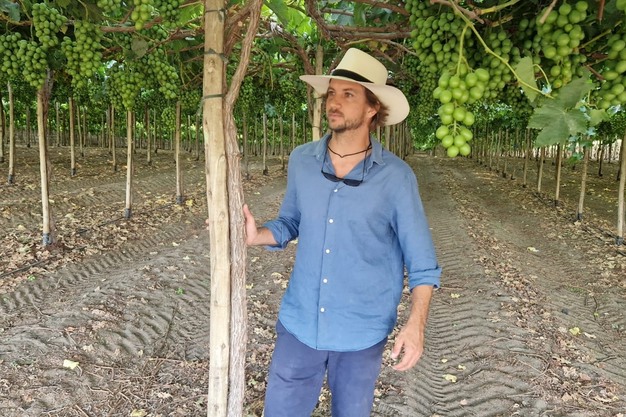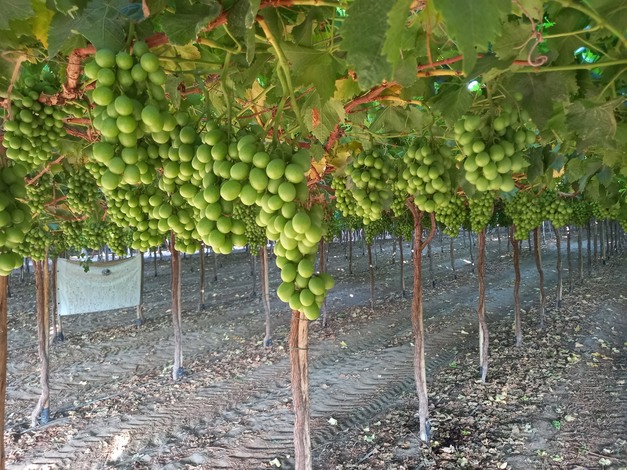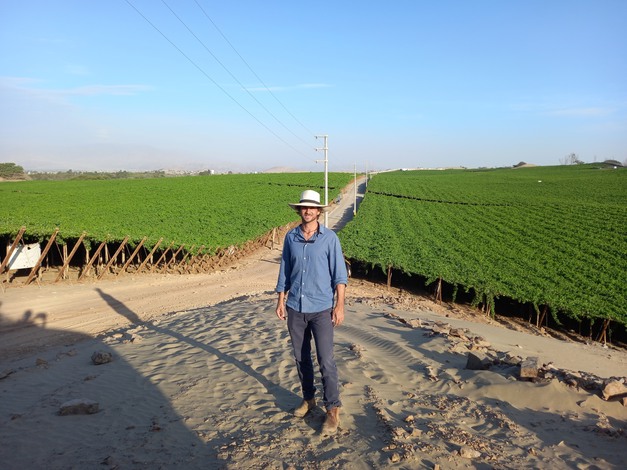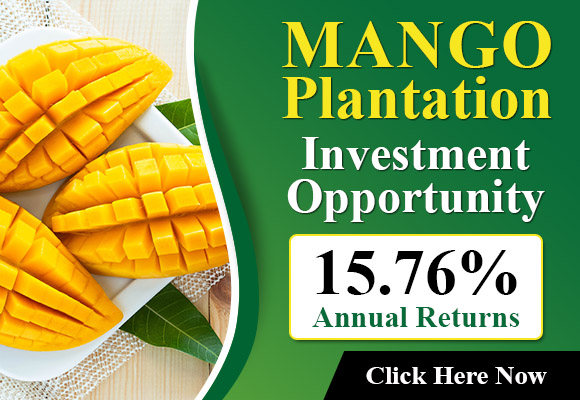Based in Ica, the Peruvian department that alone accounts for more than half of the country’s table grape exports, Cristóbal Cillóniz has been committed to this emblematic crop for three years. He founded the company Agrícola Procom in the region and had a 90-hectare plot planted.
Since November 2024, the project has been part of the Rocio Group, one of the most diversified agro-industrial conglomerates in Peru, “with operations involving blueberries, avocados, asparagus, poultry and livestock. In 2024, the group decided to take a dive into the table grape business,” says Cillóniz, co-owner of Talsa Grape Farms, the entity in charge of the production and marketing of the group’s table grapes.
 © FreshPlaza
© FreshPlaza
Cristóbal Cillóniz.
At the La Huerta estate, Cillóniz bet it all on the Autumncrisp, a patented variety that has gained ground globally for its flavor, size and crunchy texture. “The Autumncrisp works exceptionally well in Ica,” he says.
He currently has 83.5 hectares planted and is adding an additional 100 hectares. In the first year of production (the first harvest arrived 13 months after planting) the yield per hectare reached 2,000 boxes; next season, which will be the third year of harvesting, it will reach 4,500 boxes.
In any case, experimentation is also part of the strategy, with semi-commercial trials carried out in small plots with the Sugra 54 and Sugra 56. On another of the company’s farms in Pisco, some 120 kilometres away, they are also growing Sweet Globe, Sweet Celebration, Cotton Candy, Ruby Rush and Candy Hearts.
Changing markets and demanding consumers
The United States absorbs between 50 and 60% of the fruit exported by Talsa Grape Farms. “It’s our most important market and Autumncrisp is very well accepted there,” says Cillóniz. The main brand is Talsa Grape Farms, although clients such as Costco, Publix and others require packaging under their own brand names. 50% percent of the fruit is shipped in 8.2 kg boxes and 50% in clamshells.
 © FreshPlaza
© FreshPlaza
Autumncrisp grapes at the La Huerta estate will be harvested from 10 December (photo taken in late October).
Exporting to the United States involves paying a 10% tariff, a factor that takes a toll on profitability. “We are affected by that, of course. If it goes up or if the return isn’t competitive enough, we’ll have to ship the fruit elsewhere. But this cannot be done on a large scale, as other destinations don’t have the capacity to absorb this volume at the same price level,” he says.
Asia, especially South East Asian countries and Japan, is becoming increasingly important. “They are very demanding markets when it comes to the fruit’s size, appearance and maximum residue limits, but complying with everything will yield you very good prices. Europe isn’t as important, partly because of competition from South Africa during certain marketing periods. Mexico is an attractive market, although unstable due to occasional oversupply,” he says.
“Moreover, trends have been changing rapidly. In 2018, our entire Autumncrisp crop was going to China. Today, that’s almost down to zero,” he says. Chinese domestic production, especially of Shine Muscat, has led to a drastic reduction in the demand for imported grapes.
Outsourced packing and future investments
Talsa Grape Farms currently processes its fruit in outsourced packing houses. “We have been considering setting up our own packing facility, but we prefer investing those resources into expanding our acreage,” he says. “We’d need to invest around 7 million dollars for a facility that we would only use three or four months of the year.” For now, the company prefers to strike strategic alliances, co-investing in chambers or processing lines with third parties.
 © FreshPlaza
© FreshPlaza
Currently, the La Huerta estate has 83.5 hectares planted with Autumncrisp grapes.
Water: Ica’s physical limit
The main problem for agro-exports in Ica is the water supply. “The aquifer is draining and conductivity has risen. This is a wake-up call,” says Cillóniz. “Unlike La Libertad and Arequipa, we don’t have any state water projects, and the drilling of new wells is prohibited. Every year, between January and April, the Pisco and Ica rivers carry large volumes of water that end up in the sea and cannot be used. This is a pity. We could build dams with private investment, but there is a lack of political will. Without water infrastructure, there can’t be agricultural sustainability.”
Another challenge is the labor shortage. The grape thinning and the peak of the blueberry harvest, another labor-intensive task, take place at the same time, generating strong competition. “In the La Huerta estate alone, 400 people are needed for the harvest in the 83.5 hectares. Blueberry growth has been explosive, and that is putting a strain on the entire agricultural labor market,” he says.
Controlling quality, not the market
Cillóniz argues that the key to the future lies in quality and efficiency, not in trying to control prices. “Patented varieties help avoid the oversupply we saw with Red Globe, as well as with asparagus or avocados. But in the end, those managing to produce good quantities of good quality products at a good cost will always come out on top.”
The goal is clear: 500 hectares of table grapes in four years, moderate varietal diversification and an operation capable of adapting quickly to the ups and downs of the international market. Despite the challenges, Cillóniz remains optimistic. “If we do things right in the field and continue delivering the same quality, there will always be a market willing to pay for good grapes.”
 For more information:
For more information:
Cristóbal Cillóniz
Talsa Grape Farms SAC
Manuel Olguin 335
Santiago de Surco, Peru
[email protected]
www.talsa.com.pe
Source: The Plantations International Agroforestry Group of Companies
